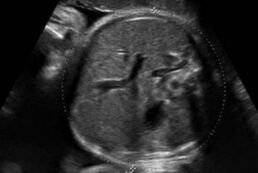Baby's Height and Weight
At 40 weeks of pregnancy, the baby’s height is about 51-52 centimeters, the size of a pumpkin. Its weight is about 3500 grams.
At the 41st week of pregnancy, the baby’s height is about 52 centimeters and weight is about 3700 grams.
Development of the Baby

At the end of this week, the 9-month 10-day pregnancy period will expire. There is a chance that you will give birth at the 40th week of pregnancy. However, it may not be what you expect and your baby may decide to stay on your belly for a little longer. You do not have to worry about pregnancy exceeding 40 weeks. According to the medical literature, as long as everything is fine, the baby can be expected to arrive until the end of 42 weeks (9 months 24 yesterday). In such a case, the doctor will recommend to follow the baby more often. Some doctors wait until 41 weeks before giving birth. In our country, the waiting period for delivery is usually up to 41 weeks in public hospitals and up to 40 weeks in private hospitals. This waiting period varies between private doctors. Most doctors who do not wait 42 weeks prefer not to put themselves at risk in the name of legal responsibility. Doctors who wait 42 weeks wait for birth because they trust the nature of the mother and baby, they are experienced in normal birth, and as long as everything is fine, there is no inconvenience until the end of 42 weeks medically.
You should have already determined your preference for which week you want to wait until this time and you should have chosen your doctor according to this preference. (For detailed information on preferences at birth, Week and You can check out our 34th weekly articles.)
When your baby is born, the nurse removes mucus and amniotic fluids from the baby’s mouth and nose. The production of surfactant, which starts in the last 3 months of birth, performs its task immediately after birth, causing the lungs to swell. This will allow the baby to breathe comfortably when it comes to the outside world. Since surfactant production in premature babies is incomplete, artificial surfactant is given to these babies and respiratory support is provided in the incubator.
Evaluation of the Postpartum Baby
If the birth occurred during 40 weeks of pregnancy, the pediatrician evaluates the Apgar Score after the birth. The assessment checks for:
– Movements and muscle tone,
– Pulse, i.e. heart rate,
– Face reflexes (crying and grimace response),
– Skin colour,
– Respiratory rate and exertion.
These assessments will determine the baby’s first health measure, the Apgar score. In this evaluation, which is named after the American Doctor Virginia Apgar, the baby is given a score of 2-10 depending on his/her health status. A score of 7 or above indicates that the baby is in good condition.
Why Is Postpartum Skin-to-Skin Contact Important?
When babies are born, there is not as much blood on their skin surfaces as it is thought. For nude skin-to-skin contact with the mother after birth, the baby can be easily cleaned with a towel and given to the mother’s lap, and they are allowed to touch each other with the Skin-to-Skin Contact application. Cutting the umbilical cord late for about 1 minute allows the baby to leave a symbol that he/she trusts with calmness and prevents anemia in the baby. As soon as the baby is born, it will be given to the mother’s lap and the baby will calm down with the mother’s heartbeat. Considering that the baby only needs the mother’s lap before applications such as cleaning (washing) or vaccination after birth, this method has been preferred in recent years. You can request your doctor to perform the Skin-to-Skin Contact application, which is preferred even in some public hospitals, on you during your pregnancy.
After birth, it is very valuable that the baby does not get away from his mother during and after the Apgar test. If there is no emergency, the baby should not be separated from his mother between the first 45 minutes and 1 hour. Thus, the baby feels safe by relaxing with the voice of his parents, which is the most familiar voice, and their feeling of encapsulation (natural incubator effect). It is stated that meeting this need of babies to feel safe immediately after birth will enable them to have a much calmer structure and to have confidence in life, including infancy. If you request all these applications in advance, you will not be disappointed after birth.
40-Week Pregnancy Baby Movements
Ultrasound Image

Your doctor may not perform an ultrasound examination this week. It may be enough to evaluate the baby’s heartbeat with the NST device. If ultrasound is needed, it will look at the condition of the amniotic fluid and the general condition of the baby.
Changes in the Mother's Body
You are now ready to give birth.
What are the signs of childbirth at 40 weeks of pregnancy? To find out, you can look at the birth symptoms section in our 39 weeks article.
Phases of labor
How does childbirth occur? This is one of the most preoccupying questions for expectant mothers. Here are the stages of birth…
First Stage
Hidden stage: It begins with regular labor contractions (lasting 30-60 seconds every 15-20 minutes) and the softening and thinning of the mucus (cervix) in the cervix and slowly opening. This phase lasts at least 8 hours.
Active phase: With the complete arrival of mucus in the cervix, the opening increases to 3 centimeters. The contractions are more regular and rhythmic (every 10-15 minutes). The time between contractions first decreases to 5 minutes, then to 2 minutes. At the end of this phase, each contraction lasts 60-120 seconds. As the baby progresses through the birth canal, the cervix experiences the fastest opening period between 4-9 cm. The duration of the active phase varies according to the number of births of the expectant mother. The first pregnancy opens 1 centimeter every 1 hour.
If labor does not progress after the cervix is opened 4-5 centimeters, the obstetrician may recommend opening the uterine membrane with the help of a thin long apparatus. This process speeds up uterine contractions and allows the baby to put more pressure on the cervix. This is a painless procedure. This procedure is not performed in preterm birth.
Second Stage
Transition phase: It is the phase in which the lovex expands further and opens completely 10 cm. At the end of this phase, the urge to push comes. It is a difficult phase in terms of pain because the contractions come every 60-90 seconds and last an average of 30-60 seconds. This stage is expected to be 20-50 minutes according to the number of births of the expectant mother. It is not desired to last more than 1 hour.
Willingness to push: At this stage, that is, when the will to push comes, the cervix must be sufficiently opened. If it is not opened sufficiently, the birth supporter will allow the expectant mother to take short breaths to open the cervix. Focusing on this breathing pattern prevents you from pushing. If straining occurs from cervical enlargement, the baby’s head may be born slightly elongated (it improves sometime after birth) and vaginal tears may occur in the mother. In a natural birth, the goal should be to open the cervix slowly and ensure that the baby comes out slowly. You should only push when your midwife tells you to push. In some births, the baby can be born slowly without even having to push. Do not think that your baby will be out of breath in this process, because contact with the air has not started yet. Finally, after the baby slips out of the birth canal, the labor pains end.
Third Stage
In this last stage, the umbilical cord is cut. At the same time, the birth of the placenta and membranes takes place. It should be ensured that the placenta emerges quickly and accurately. A hemorrhage occurs as the placenta separates from the uterine wall. After 5 minutes, this bleeding stops and the uterine muscle walls begin to tighten.
Points need to be considered
Nasıl bir doğum hayal ettiğinizi doktorunuzla tekrar konuşun. Eğer ağrı çekmek istemiyorsanız epidural doğum yapabilirsiniz. Yalnız son yıllarda anne adaylarının fazlasıyla teşvik edildiği epidural anesteziyle doğumun avantajları kadar dezavantajlarını da bilip kararı o şekilde vermenizin çok daha önemli olabileceğini unutmayın.
Epidural Delivery
Advantages
– Provides rest when labor is prolonged,
– Reduces the discomfort of childbirth, helps some women have a positive birth experience.
Disadvantages
– Epidural delivery is a kind of medicated intervention to the nature of the mother and the baby. For this reason, it inhibits the hormone oxytocin and the hormone endorphin, which initiate labor. This can negatively affect consciousness, cause weakening of contractions and prolongation of labor,
– A severe headache may occur,
– Blood pressure may drop suddenly. Therefore, it may be necessary to control adequate blood flow to the baby,
– Pain, back pain, tremor, ringing in the ears, difficulty urinating or nausea may occur where the needle is inserted,
– Interventions such as forceps or cesarean section may be needed because the feeling of straining decreases in deliveries with epidural,
– It may cause the birth process to slow down or stop because it will be necessary to stay in a certain position in bed (due to the restriction of the movements of the expectant mother),
– It may cause an increase in the fetal heart rate variability of the baby. In this case, some interventions may be needed (vacuum, forceps, episiotomy (vaginal incision), cesarean delivery),
– Although research is not conclusive, it shows that it may cause breastfeeding difficulties in some babies, as it may adversely affect the secretion of the prolactin hormone required during breastfeeding,
– Permanent nerve damage to the mother may occur in the area where the catheter is placed with a low probability.
Canbebe on Social Media!
Join our community of mothers and fathers on social media. Be close to caring community, sharing advices between each other on our everyday life with our baby.
